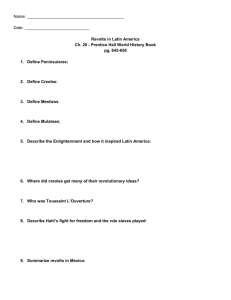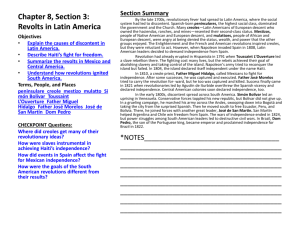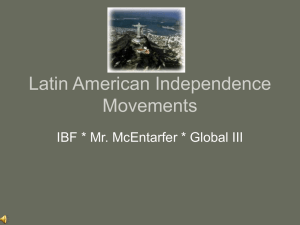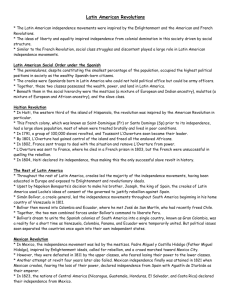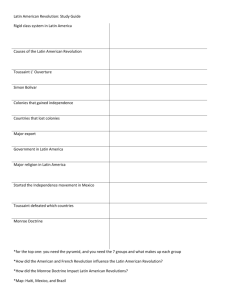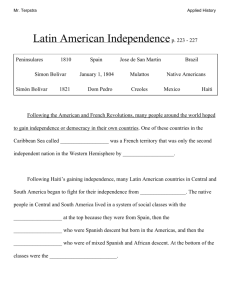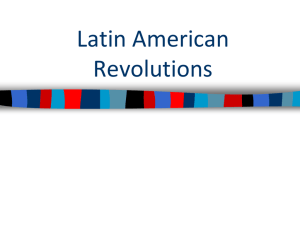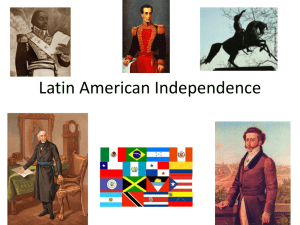Latin American Revolutions: Causes and Key Figures
advertisement
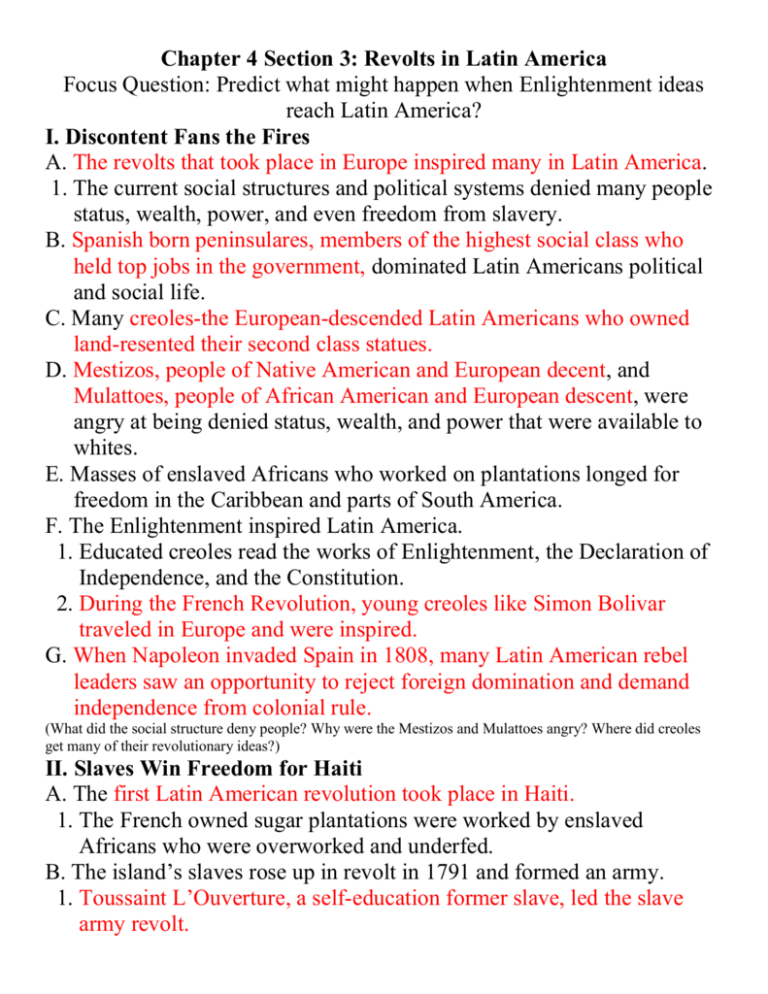
Chapter 4 Section 3: Revolts in Latin America Focus Question: Predict what might happen when Enlightenment ideas reach Latin America? I. Discontent Fans the Fires A. The revolts that took place in Europe inspired many in Latin America. 1. The current social structures and political systems denied many people status, wealth, power, and even freedom from slavery. B. Spanish born peninsulares, members of the highest social class who held top jobs in the government, dominated Latin Americans political and social life. C. Many creoles-the European-descended Latin Americans who owned land-resented their second class statues. D. Mestizos, people of Native American and European decent, and Mulattoes, people of African American and European descent, were angry at being denied status, wealth, and power that were available to whites. E. Masses of enslaved Africans who worked on plantations longed for freedom in the Caribbean and parts of South America. F. The Enlightenment inspired Latin America. 1. Educated creoles read the works of Enlightenment, the Declaration of Independence, and the Constitution. 2. During the French Revolution, young creoles like Simon Bolivar traveled in Europe and were inspired. G. When Napoleon invaded Spain in 1808, many Latin American rebel leaders saw an opportunity to reject foreign domination and demand independence from colonial rule. (What did the social structure deny people? Why were the Mestizos and Mulattoes angry? Where did creoles get many of their revolutionary ideas?) II. Slaves Win Freedom for Haiti A. The first Latin American revolution took place in Haiti. 1. The French owned sugar plantations were worked by enslaved Africans who were overworked and underfed. B. The island’s slaves rose up in revolt in 1791 and formed an army. 1. Toussaint L’Ouverture, a self-education former slave, led the slave army revolt. 2. By 1798, the rebels had won control of most of the island and slavery was abolished. C. Haiti wins independence. 1. In 1802, Napoleon sent an army to conquer the former colony. 2. The Haitians urged by Toussaint L’Ouverture fight again. 3. France surrendered in 1803. (Why did the sugar plantation slaves revolt? Toussaint L’Ouverture led a revolt that eventually resulted in whom independence? How were the slaves instrumental in achieving Haiti’s independence? What do you think the Haitians would have preferred in a battle, death or being caught and enslaved again? Why?) III. Mexico and Central America Revolt A. In 1810 Mexican mestizos and Native Americans stood up against Spain at the urging of Father Miguel Hidalgo. 1. He appeal to them in his speech that became known as “el Grito de Dolores,” the cry for Dolores. 2. It called Mexicans to fight for independence. B. The Mexican revolutionaries finally overthrew the Spanish victory and eventually set up the Republic of Mexico in 1820. (What did “el Grito de Dolores” represent?) IV. Revolution Ignites South America A. Simon Bolívar begins the fight. 1. The discontent among the Creoles spread across South America. 2. In 1808, when Napoleon occupied Spain, Bolivar and his friends saw the occupation as a signal to act. B. Simon Bolívar who was known as the Liberator and his forces freed Venezuela, Ecuador, Peru, and Bolivia. C. Another creole, José de San Martín, worked his way up from the south, freeing helping in freeing Argentina, Chile, and then meeting up with Bolívar to liberate Peru. D. Brazil also became independent, although it remained a monarchy until 1889 when social and political turmoil let it to become a republic. E. The result of Latin American independence was that Latin American nations were independent, but they were not democratic. (What event spurred Simon Bolívar to begin the struggle for independence? What led to widespread drive for independence in South America? Describe the result of Latin American independence.)
